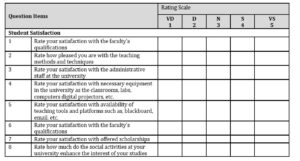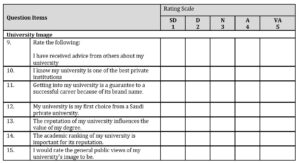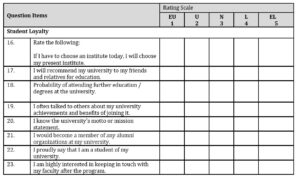Introduction
Saudi Arabia has undergone remarkable economic diversification, propelling significant changes in its higher education system in recent years. The establishment of 12 new public universities and 5 private universities since 2006 has marked a significant expansion of educational opportunities fostering growth and access to higher education all over the country, as well as making Saudi Arabia one of the fastest-growing education systems in the Middle East due to its numerous prestigious universities (Abu Najm, 2022). This significant expansion of educational opportunities fosters growth and access to higher education all over the country and makes Saudi Arabia one of the fastest-growing education systems in the Middle East due to its numerous prestigious universities. Since 2016, Vision 2030 has given education development particular attention in order to assist Saudi Arabia become one of the world’s most prosperous countries. (Sohail & Hasan, 2021). The Vision of 2030 also entitles vital elements in equipping the younger generation with the educational opportunities that will enable them to become productive members of the Saudi society.
To address these developments, the higher education system in Saudi Arabia is required to adopt unique approaches to tackle the challenges faced by universities (Alharbi, 2016). As this sector experiences rapid growth, it also faces escalating competition among other institutions competing for student enrollment and retention. During the 2020 recession, the country faced a sharp decline in economic activity, making it difficult for students to afford high-cost educational expenses. This combination of fierce competition and an extremely cut-throat environment in higher education propels the need to build loyalty among the students through customer-focused strategies (Leonnard et al, 2015).
The city of Jeddah, in particular, is a hotspot for intense competition among private universities. This intense rivalry makes it hard to attract and retain students. Lack of student loyalty is a threat that can have detrimental ramifications for universities. When students are not loyal to their institution, they may be more likely to spread negative word-of-mouth, transfer to a different university, or even drop out altogether, leading to a decline in enrollment and revenue for the institution. Consequently, it becomes critical for private universities to thoroughly understand the mindset and motives of the new generation of students and the factors influencing their students’ loyalty. Building and nurturing student loyalty is crucial as it directly impacts their reputation, enrollment rates, and financial performance (Amin, 2021).
Issues pertaining to student loyalty have already been addressed by various scholars such as Ngwira and Intravisit (2023) and Kieng et al. (2021), yet no relevant studies have been found on student loyalty in universities in Saudi Arabia. Hence, the purpose of the present study involves identifying the factors that affect student loyalty in Saudi Arabia. The significance of this study lies in its two main contributions. Firstly, it addresses the limited research conducted and fills the literature gap on the factors influencing student loyalty in Saudi Arabia. Secondly, these research findings serve as a valuable resource for private universities and researchers to make informed decisions to cultivate stronger relationships with their students.
The study thus aims to achieve four primary objectives. First, to identify the main factors that influence Student loyalty toward Saudi private universities. Second, to analyze the relationship between the different factors on student loyalty. Third, to measure the impact of each factor on student loyalty. Fourth, to formulate recommendations for Saudi private universities to enhance student loyalty.
Literature Review
This review is structured thematically to conceptualize student loyalty, explore the different factors influencing loyalty, and develop the main hypotheses of the study focus while relating the review to the context of Saudi private universities.
Students as Customers in a University Setting
Students are considered ‘customers of educational services’; this is especially true in the case of private universities, where students actively choose a university and pay tuition fees in exchange for educational services. Therefore, students are expected to be treated as customers throughout their university journey (Tariq et al., 2020). Research by Todea et al. (2022) confirms no discernible difference between students and consumers of other services. As such, education can be considered a service, and students as customers are in a position to determine what they expect from a university and evaluate the quality of service provided. Based on the research of Paul and Pradhan (2019), students of private universities carry the expectation of being regarded as paying customers and require a high standard of service delivery. Due to this, maintaining student loyalty is considered a crucial aspect in private universities as it ensures that students remain committed to their university.
Student Loyalty
Student loyalty is the degree of connection students feel toward their university, and how it is expressed through their attitudes and behaviors (Snijders et al., 2020). This study explores the concept of student loyalty in other countries and then applies these existing frameworks in the realm of Saudi private universities.
A study by Todea et al. (2022) elaborated that student loyalty refers to students’ commitment to their university following their educational experience. According to Snijders et al. (2020), loyalty can be expressed in different forms, such as positive recommendations from students about their university or engaging in extracurricular programs. This paper also examines other possible loyalty effects, such as positive word-of-mouth and commitment toward the university. Kieng et al. (2021) explain that loyal students are more likely to speak positively about their university. In line with what Mulyono (2020) stated, the behavior of university students in sharing positive experiences, making recommendations to others, and giving referrals is affected by their overall satisfaction and the brand image of their university. Another kind of loyalty is present in “retention” which is one of the main dimensions measuring student loyalty by enrolling and persisting in the university (Mulyono, 2020).
The Student Loyalty Model & Hypothesis Development
All evaluations of student loyalty indices are fundamentally based on a classical model that includes sources and consequences of student loyalty (Tariq et al., 2020). The student loyalty model is fundamental to understanding the main factors that influence student loyalty. Many factors impact student loyalty; however, the objective of this research is to identify the main factors that are significant and form an integral part of the model.
Several researchers, such as Leonnard et al (2015) and Snijders et al. (2020), have developed various models to conceptualize the student loyalty model. The research framework of Ngwira and Intravisit (2023) suggests that independent variables such as university image, reputation, functional service quality, and student perceived value are associated with student satisfaction, which leads to student loyalty. Similarly, the models of Kieng et al. (2021) and Mulyono (2020) prove some common variables. Thus, it can be concluded that recent literature identifies student satisfaction and university image as the main pillars of the student loyalty model. This review will define and elaborate on the three main pillars as follows:
Student Satisfaction
Kieng et al. (2021) define student satisfaction as the favorable evaluation of various student experiences provided by a university. Research by Ngwira and Intravisit (2023) defines student satisfaction as “a temporary approach caused by an appraisal of students’ academic experience, services, and facilities”. According to several research results, focusing on improving student satisfaction is crucial for developing student value and fostering student loyalty. Student satisfaction has been identified as the major driver of student loyalty. Therefore, when students are satisfied with their educational institution, they will be more likely to remain loyal to it and spread a positive image of it (Tariq et al.,2020 and Paul & Pradhan, 2019).
H1: Student satisfaction has a significant effect on student loyalty.
Student satisfaction and retention at Saudi universities are largely driven by the quality of the services they receive. It is predominantly derived from the combination of excellent learning and non-learning processes (Azam, 2018). Moreover, Allam and Malik (2020) and Sibai et al. (2021) identified the predictors of student satisfaction in Saudi universities as instructor performance, service delivery, and support facilities. Numerous studies have been conducted on student satisfaction, and the findings suggest several factors influencing it, as seen in Table 1.
Table 1: Student Satisfaction Dimensions in Recent Literature
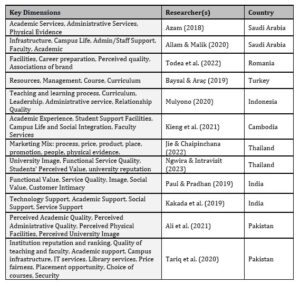
These student satisfaction dimensions vary across contexts and countries with little consensus on the different constructs. As this vein of research focuses on exploring the main determining factors in Saudi universities, the most common ones that will be elaborated on are academic experience, and student life and support.
Academic Experience
The academic experience is a critical component of student satisfaction as students attend college with the expectation of receiving a high-quality education (Kakada et al., 2019). It encompasses a range of variables that can impact student satisfaction. Therefore, the obvious factors affecting students’ academic experiences are academic resources, service quality, and teaching quality. Resources are vital to the academic experience. Students need access to resources such as libraries, computer labs, and research facilities to support their academic pursuits (Kieng et al, 2021). Weerasinghe and Fernando (2017) explored the influence of service quality on student satisfaction and found that cooperation and the amiability of administrative staff are crucial factors in shaping student satisfaction. Furthermore, teaching quality can be assessed through several factors. Li et al. (2022) reveal that the academic experience of the faculty and academic professionalism are important indicators influencing student satisfaction.
H2: Academic experience significantly affects student satisfaction.
Student Life and Support
Student support facilities greatly influence student satisfaction. In 2019, Kakada et al. emphasized a strong positive correlation relationship between student satisfaction and student support facilities. Azam (2018) adds that higher education institutions must focus on every aspect of the student’s experience at the institution to achieve student satisfaction. Social interactions, availability of scholarships, and perceived fairness of tuition price are the main factors affecting student life and support. Thus, a positive campus life experience and social integration can lead to a greater sense of community and a more enjoyable college experience (Kieng et al., 2021). According to Tariq et al. (2020), prioritizing price fairness and offering scholarships attract and retain satisfied students, promote access to education, and build a positive reputation. Fair pricing leads to higher student satisfaction, while pricing that exceeds the value of facilities provided results in dissatisfaction, dropouts, or even switching.
H3: Student life and support have a significant effect on student satisfaction.
University Image
According to Ali et al. (2021), the concept of university image pertains to the way the institution is viewed by external and internal stakeholders. Research by Ngwira and Intravisit (2023) illustrates that a university’s image is determined by its trustworthiness, reputation, heritage, and its campus culture. Findings from Mulyono’s (2020) research concluded that university image significantly shapes student satisfaction and loyalty. The research by Paul and Pradhan (2019) also suggested that the university’s reputation, academic rankings, and image are paramount to the formation of a student’s loyalty. In the context of Saudi Arabia, Muhammad et al. (2020) indicate that reputation and trust are fundamental factors in Saudi Arabia where customers mainly rely on recommendations from family and friends. Studies have indicated that the retention and loyalty of students are significantly influenced by the reputation and image of the university. Findings by Ngwira and Intravisit (2023) and Kieng et al. (2021) reported that university image had a strong impact on students’ loyalty.
H4: University image has a significant effect on student loyalty.
Besides, prior research has shed some light on the relationship between university image and satisfaction. Recent studies by Kieng et al. (2021) and Mulyono (2020) have highlighted that the image of a university serves as a mediator and improves students’ satisfaction. As stated by Paul and Pradhan (2019), previous studies have discovered that the image of an institution has a significant impact on student satisfaction formation and ultimately leads to students’ loyalty toward the institution.
H5: University image has a significant effect on student satisfaction.
In conclusion, the student loyalty model is a widely-used framework; after an extensive review of the literature, five hypotheses were conceived based on the modification of prior research frameworks on student loyalty proposed via two papers by Ngwira and Intravisit (2023), and Kieng et al. (2021). As for the students’ satisfaction antecedents, they were concluded from recent studies in Saudi Arabia by Allam and Malik (2020) and Azam (2018).
Research Methodology
Research Design
The researchers conducted applied research to address the issue at hand. To execute the study, the researchers utilized a descriptive research design by gathering objective data that reflected the relationship among the different variables. According to Tariq et al. (2020), descriptive analysis is used when researchers specifically need to answer the questions of “what is” and “what was”. Borishade et al. (2021) applied descriptive design to answer the research questions and to be able to evaluate different variables in a succinct and scientific manner. Starting with journals, the researchers reviewed the available literature and found the knowledge gap. The literature review is crucial in research as it supports building conceptual models and filling the gap in the market. The researchers then relied on primary data, with structural self-administered online questionnaire deployment, as the main data-gathering method, as it is time-efficient, provides easier access to the target audience, and captures a larger sample of the study population (Tariq et al., 2020). The questionnaire consisted of two sections: the socio-demographic section and the evaluation of variables. All these variables were tested based on a 5-point Likert scale to investigate the significance of each hypothesis.
Sampling and Data Collection
The population of this study comprised undergraduate and graduate students of three private universities in Jeddah city, which counted 3,860 individuals. Todea et al. (2022) recommended choosing universities that have similarities when sampling. Hence, the researchers have selected these three universities as they offer their students relatively comparable educational experiences and services, and all three were founded more than 20 years ago. Besides, simple random sampling was followed to reach the sample group. The researchers followed a mono-method using a quantitative survey: questionnaires. 320 respondents accepted to participate in the study and their answers were complete; however, only 302 responses were valid and considered for the analysis stage. The researchers utilized SPSS to analyze data and formulate the results. The data were collected in May 2023.
Ethical Considerations
To avoid common ethical issues, such as the universities’ and participants’ privacy, during the data-collection process, all participants were informed about the research purpose and how the data would be used, and they voluntarily agreed to participate, ensuring their anonymity.
Validity and Reliability
To ensure the questionnaire’s validity and reliability, the researchers adapted all the questionnaire questions from previous peer-reviewed studies by Amin (2021), Jie and Chaipinchana (2022), and Paul and Pradhan (2019) which addressed the same topic in other countries. This was done with minor adjustments to some questions to match the study settings and environment.
Results
The final survey results were obtained from a sufficient sample of 302 students. The data collected were analyzed using descriptive analysis and hypothesis testing.
Descriptive Statistical Analysis
Table 2: Demographic Profile of the Respondents
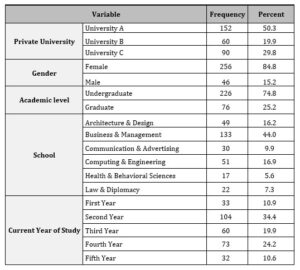
Table 2. shows the demographic characteristics of all respondents. It can be concluded that the respondents were from different universities, years of study, and gender, a varied range of university levels was represented in the sample. The majority of the sample size was female, accounting for 84.8% of respondents. Male students, on the other hand, made up only 15.2% of the sample. It is worth noting that this gender distribution is because some of the sampled universities were exclusively established for female students, and only recently started enrolling male students. Similarly, the majority of respondents were undergraduate students, accounting for 74.8% of the sample, while graduate students made up a smaller percentage of the sample, at 25.2%.
Table 3: Summary Descriptive Statistics of Variables
Table 3 above indicates that sampled students were generally satisfied with their Academic Experience at their university with a mean average value of 3.85, and Student Life with a mean score of 3.32. Academic Experience had the highest mean, while Student Support and Life received a neutral average. Furthermore, University Image had positive results, with a mean score of 3.82, and students were generally perceived as loyal to their university with a mean of 3.66.
Table 4: Descriptive Statistics and Answers of Respondents on Statement.
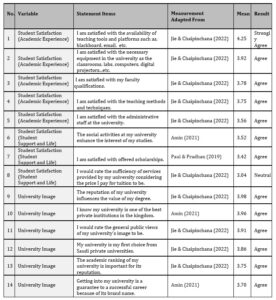
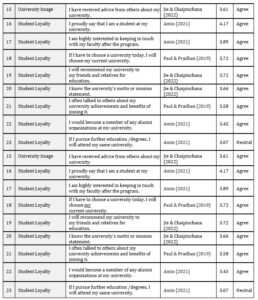
Testing of Hypotheses
Correlation analysis and analysis of variance (ANOVA) were used to assess the relationship between variables and sub-variables to test the main hypothesis and assess its significance.
Table 5: Summary of Hypotheses Correlations and Significance Level
The summarized test results evaluated and discussed in Table 5 above show that:
H1: Student satisfaction has a significant effect on student loyalty.
The value of R is 0.690, which indicates a moderate positive correlation between Student Satisfaction and Student Loyalty. The p-value is below the significance level of 0.05, thus the hypothesis is true.
H2: Academic experience significantly affects student satisfaction.
R-value 0.88 indicates a strong positive correlation between Academic Experience and Student Satisfaction. These findings present the p-value of the ANOVA below the significance level; thus, the hypothesis is true.
H3: Student life and support has a significant effect on student satisfaction.
The value of R-value is 0.922, which indicates a strong positive correlation between Student Satisfaction and Student Life and Support. The p-value is below the significance level; thus, the hypothesis is true.
H4: University image has a significant effect on student loyalty.
R-value of 0.777 shows a strong positive correlation between University Image and Student Loyalty. The p-value is below the significance level of 0.05, thus the hypothesis is true.
H5: University image has a significant effect on student satisfaction.
R-value of 0.649 indicates a moderate positive correlation between Student Satisfaction and University Image. The p-value is below the significance level of 0.05, thus the hypothesis is true.
After the above analysis, the hypothesis test conclusion of the research is as follows:
Table 6: Conclusion of Hypothesis Testing

The results show that the five hypotheses of this research were accepted: H2, H3, and H4 have a strong positive correlation, whereas H1 and H5 have a moderate positive correlation
Discussion
This discussion answers the main research questions and addresses the objectives by identifying the factors that influence students’ loyalty toward Saudi private universities in addition to analyzing the relationships and measuring each factor’s impact on Student Loyalty. The findings confirm the literature review that the Student Loyalty Model can be used as a framework to understand the factors that influence Student Loyalty. Hence, the framework of this study derived from prior frameworks proposed by Ngwira and Intravisit (2023), and Kieng et al. (2021), is valid including the two variables of Student Satisfaction and University Image impact on Student Loyalty.
Using the five accepted hypotheses, the researchers examined the relationship between different factors on Student Loyalty and measured how each factor impacts loyalty; thus, the below correlations were deduced.
H1: Student Satisfaction has a significant effect on Student Loyalty.
The results show a moderate positive relationship between Student Satisfaction and Student Loyalty which means an increase in Student Satisfaction in Saudi private universities will cause a reasonable, not substantial, increase in Student Loyalty. Some factors play a role in this relationship, including the amount of tuition fees and the satisfaction with administrative staff. Compared to public universities, private universities in Saudi Arabia charge students a hefty sum for similar services. Student Satisfaction should be guaranteed since they are paying for these services. This outcome is consistent with the result reported by Ngwira and Intravisit (2023); Ali and Ahmed (2018); Chandra et al. (2018); and Tariq et al. (2018), who concluded a significant direct impact of Student Satisfaction on Student Loyalty. Besides, Todea et al. (2022) confirmed a significant impact of Student Satisfaction on loyalty; however, the relationship was indirect. Furthermore, Tariq et al. (2020); and Ali and Ahmed (2018) reported a strong impact of Student Satisfaction on Student Loyalty as those students satisfied with their university tend to spread positive feedback about their universities, which is a consequence of Student Loyalty. Nevertheless, Rojas-Méndez et al. (2009, as cited in Ali & Ahmed, 2018) rejected the impact of Student Satisfaction on Student Loyalty.
H2: Academic Experience significantly affects Student Satisfaction.
H3: Student Life and Support have a significant effect on Student Satisfaction.
According to the correlation analysis, these hypotheses have a strong positive impact on the dependent variable, Student Satisfaction. These results are also approved by Ali and Ahmed (2018); and Chandra et al. (2018), whose studies revealed a significant impact of the quality of Academic Experience and physical facilities on Student Satisfaction. Research by Ngwira and Intravisit (2023) confirmed a reasonable impact of functional service quality on Student Satisfaction. While there are proponents of this correlation, detractors equally exist. Kieng et al.’s (2021) study rejected the effect of the Academic Experience on Student Satisfaction. The variance in the results between the current study, under the context of Saudi Arabia, and the study of Kieng et al. (2021), in Colombia, is due to cultural differences between the two countries. Depending on the context, respondents have different mindsets and varying standards when it comes to evaluating their satisfaction.
H4: University Image has a significant effect on Student Loyalty
The findings confirmed that University Image has a strong positive correlation with Student Loyalty, which is similar to the results of Tariq et al. (2022); Kieng et al. (2021); and Ali and Ahmed (2018). On the other hand, the University Image has a moderate impact on Student Loyalty, as reported by Ngwira and Intravisit (2023). The difference in the relation intensity between the studies is due to the cultural differences and the variations in the studies’ contexts.
H5: University Image has a significant effect on Student Satisfaction.
The tests have proven that University Image has a moderate positive correlation with Student Satisfaction. Respondents’ answers on the questionnaire reflected the importance of University Image in supporting Student Satisfaction and the value of their studies. The study of Ngwira and Intravisit (2023) and Kieng et al. (2021) align with this finding. Nevertheless, Panda et al. (2019) and Ali and Ahmed (2018) highlighted an inverse relationship where their studies confirm a significant impact of Student Satisfaction on University Image. They considered Student Satisfaction was a prerequisite for building a positive University Image, and their hypothesis was accepted. Satisfied students help in building a strong image for the institution.
In a nutshell, Academic Experience and Student Life and Support strongly correlate with Student Satisfaction, whereas University Image has a moderate positive correlation with Student Satisfaction. In contribution to Student Loyalty, University Image strongly correlates with Student Loyalty, whereas Student Satisfaction has a moderate relationship with Student Loyalty. This result is similar to that found in Ngwira and Intravisit’s (2023) study where they concluded that University Image has a stronger correlation with Student Loyalty than Student Satisfaction.
Recommendations
Finally, this research formulated a set of recommendations for Saudi private universities to enhance Student Loyalty and improve their marketing strategies as follows:
- Boosting University Image: emphasize and invest more in promoting their positive brand image through both digital and traditional communication channels.
- Improving Academic Experience: ensure that their academic programs remain up-to- date, relevant, and rigorous. Additionally, invest in modern facilities and technology to enhance the learning experience for students.
- Reconsidering Tuition Fees: improve their services to match their tuition fees, which can be achieved by providing more value through modern facilities and technology. Moreover, consider alternative pricing models such as income-based tuition or deferred payment plans.
Limitations & Future Studies
Several limitations were encountered that should be considered when interpreting the results and implications of this study. The time limitation restricted the study’s depth and breadth, forcing the researchers to collect data within a specific duration. The small sample size of the study included only private universities in Jeddah. Moreover, the findings are specific to the cultural, social, and economic factors present in Saudi Arabia. The research relied primarily on surveys as the method of data collection that might have only captured part of the full range of factors influencing student loyalty. Additional qualitative methods could have provided a more in-depth understanding and rich insights into students’ perspectives. Despite these limitations, the researchers believe that this research provides valuable insights. Future studies could address these limitations by adopting a longitudinal design, utilizing multiple data-collection methods, and expanding the sample size to enhance the generalizability of the findings.
Conclusion
This study was conducted to examine the various factors influencing student loyalty in Saudi private universities and to measure the relationships and impact of these factors. The building blocks of student loyalty in Saudi private universities were determined to be student satisfaction (comprising the academic experience, student life, and support) and university image. The findings showed that Academic Experience and Student Life have a strong positive correlation with Student Satisfaction, and University Image has a moderate positive correlation with Student Satisfaction. In contribution to Student Loyalty, University Image strongly correlates with Student Loyalty, whereas Student Satisfaction has a moderate relationship with Student Loyalty. The outcomes of this research paper support the global literature by demonstrating a significant impact with a positive correlation of each factor on student loyalty.
References
- AAmin, I., 2021. Understanding the Dynamics Between Trust, Student Loyalty and Word-of-Mouth: A Case of Higher Education Institutions. IUP Journal of Marketing Management, 265-284.
- Abu Najm, M., 2022. Universities established during the reign of King Abdullah bin Abdulaziz. Al-Mursal | https://www.almrsal.com/post/1200736
- Alharbi, E.A.R., 2016. Higher education in Saudi Arabia: Challenges to achieving world-class recognition. International Journal of Culture and History, 2(4), pp.169-172.
- Ali, M., Amir, H. and Ahmed, M., 2021. The role of university switching costs, perceived service quality, perceived university image and student satisfaction in shaping student loyalty. Journal of Marketing for Higher Education, pp.31(2).
- Allam, Z. and Malik, A., 2020. Exploring the Predictors of Student Satisfaction: A Case of Undergraduate Business School in King-dom of Saudi Arabia. Universal Journal of Educational Research, 8(11B), pp.5760-5767.
- Azam, A., 2018. Service quality dimensions and students’ satisfaction: A study of Saudi Arabian private higher education institutions. European Online Journal of Natural and Social Sciences, 7(2), .pp-275-284.
- Ali, M., & Ahmed, M. 2018. Determinants of Students’ Loyalty to University: A service-based Approach. Munich Personal RePEc Archive1-47
- Baysal, Z.N. and Araç, K.E., 2019. Conditions Determining Quality in Higher Education: Factors Affecting Satisfaction Levels of Prospective Teachers. Universal Journal of Educational Research, 7(1), pp.250-258.
- Borishade, T.T., Ogunnaike, O.O., Salau, O., Motilewa, B.D. and Dirisu, J.I., 2021. Assessing the relationship among service quality, student satisfaction and loyalty: the NIGERIAN higher education experience. Heliyon, 7(7), p.e07590.
- Jie, P.E.N.G. and Chaipinchana, P., 2022. Factors Affecting Brand Loyalty of Private Universities: Case Study Guangxi University of Foreign Languages. Psychology, 12(6), pp.369-383.
- Kieng, R., Phothikitti, K. and Vongurai, R., 2021. Critical Factors Affecting Student Satisfaction and Loyalty: An Empirical Study in Cambodia. The Journal of Asian Finance, Economics and Business, 8(7), pp.225-234.
- Kakada, P., Deshpande, Y. and Bisen, S., 2019. Technology Support, Social Support, Academic Support, Service Support, and Student Satisfaction. Journal of Information Technology Education, 18.
- Leonnard, L., Daryanto, H.K., Sukandar, D. and Yusuf, E.Z., 2015. The loyalty model of private university student. International Research Journal of Business Studies, 7(1).
- Li, L., Yin, T.S. and Mohamad, M.N., 2022. Factors Relating to Student Satisfaction with Service Quality: A Systematic Review. Global Business & Management Research, 14.
- Muhammad, A., Shaikh, A., Naveed, Q.N. and Qureshi, M.R.N., 2020. Factors affecting academic integrity in E-learning of Saudi Arabian Universities. An investigation using Delphi and AHP. Ieee Access, 8, pp.16259-16268.
- MULYONO, H., 2020. Antecedents of student loyalty within universities in North Sumatra Province, Indonesia. The Journal of Asian Finance, Economics and Business (JAFEB), 7(12), pp.491-500.
- Ngwira, G. and Intravisit, A., 2023. Factors Influencing Undergraduate Students’ Loyalty: A Study of Thai Private Universities Offering International Programs. ABAC ODI Journal Vision. Action. Outcome, 10(2), pp.175-198.
- Paul, R. and Pradhan, S., 2019. Achieving student satisfaction and student loyalty in higher education: A focus on service value dimensions. Services Marketing Quarterly, 40(3), pp.245-268.
- Sibai, M.T., Bay Jr, B. and Dela Rosa, R., 2021. Service Quality and Student Satisfaction Using ServQual Model: A Study of a Private Medical College in Saudi Arabia. International Education Studies, 14(6), pp.51-58.
- Snijders, I., Wijnia, L., Rikers, R.M. and Loyens, S.M., 2020. Building bridges in higher education: Student-faculty relationship quality, student engagement, and student loyalty. International Journal of Educational Research, 100, p.101538.
- Sohail, M.S. and Hasan, M., 2021. Students’ perceptions of service quality in Saudi universities: the SERVPERF model. Learning and Teaching in Higher Education: Gulf Perspectives.Vol. 17(1), pp.54-66.
- Tariq, J., Khan, K., Hussainy, S. K., & Tariq, S. (2020). Antecedents and Consequences of Student Loyalty in Higher Education. JISR management and social sciences & economics, 18(2), 25-41.
- Todea, S., Davidescu, A.A., Pop, N.A. and Stamule, T., 2022. Determinants of student loyalty in higher education: A structural equation approach for the Bucharest University of economic studies, Romania. International Journal of Environmental Research and Public Health, 19(9), p.5527.
- Weerasinghe, I.S. and Fernando, R.L., 2017. Students’ satisfaction in higher education. American journal of educational research, 5(5), pp.533-539
Appendix
Questionnaire
Section I: Demographical Variables
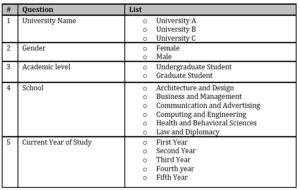
Section 2: Measuring dependent and independent variables using Likert scale

